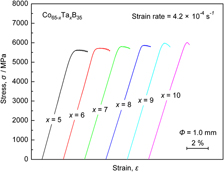Crossref Citations
This article has been cited by the following publications. This list is generated based on data provided by
Crossref.
Liu, Zengqian
Li, Ran
Wang, Gang
Wu, Sujun
Lu, Xuyang
and
Zhang, Tao
2011.
Quasi phase transition model of shear bands in metallic glasses.
Acta Materialia,
Vol. 59,
Issue. 19,
p.
7416.
Zhang, Tao
Yang, Qin
Ji, YunFei
Li, Ran
Pang, ShuJie
Wang, JianFeng
and
Xu, Tao
2011.
Centimeter-scale-diameter Co-based bulk metallic glasses with fracture strength exceeding 5000 MPa.
Chinese Science Bulletin,
Vol. 56,
Issue. 36,
p.
3972.
Wang, Jianfeng
Li, Ran
Xiao, Ruijuan
Xu, Tao
Li, Yan
Liu, Zengqian
Huang, Lu
Hua, Nengbin
Li, Gong
Li, Yanchun
and
Zhang, Tao
2011.
Compressibility and hardness of Co-based bulk metallic glass: A combined experimental and density functional theory study.
Applied Physics Letters,
Vol. 99,
Issue. 15,
Huang, Yongjiang
Zheng, Wei
He, Fulong
and
Shen, Jun
2012.
The temperature dependent dynamic mechanical response of a ZrCuNiAl bulk metallic glass.
Materials Science and Engineering: A,
Vol. 551,
Issue. ,
p.
100.
Wang, Wei Hua
2012.
The elastic properties, elastic models and elastic perspectives of metallic glasses.
Progress in Materials Science,
Vol. 57,
Issue. 3,
p.
487.
Qiao, J. W.
Zhang, Y.
Jia, H. L.
Yang, H. J.
Liaw, P. K.
and
Xu, B. S.
2012.
Tensile softening of metallic-glass-matrix composites in the supercooled liquid region.
Applied Physics Letters,
Vol. 100,
Issue. 12,
陈, 招娣
2012.
Curved Continuous Casting of Glassy Alloy Sheets.
Material Sciences,
Vol. 02,
Issue. 03,
p.
117.
Zhang, Huiyan
Li, Ran
Ji, Yunfei
Liu, Fanmao
Luo, Qiang
and
Zhang, Tao
2012.
Glass formation, magnetic properties and magnetocaloric effect of ternary Ho–Al–Co bulk metallic glass.
Journal of Magnetism and Magnetic Materials,
Vol. 324,
Issue. 23,
p.
4064.
Dun, Chaochao
Liu, Haishun
and
Shen, Baolong
2012.
Enhancement of plasticity in Co–Nb–B ternary bulk metallic glasses with ultrahigh strength.
Journal of Non-Crystalline Solids,
Vol. 358,
Issue. 23,
p.
3060.
Wang, H.
Hu, T.
Qin, J. Y.
and
Zhang, T.
2012.
Local structure origin of higher glass forming ability in Ta doped Co65B35 amorphous alloy.
Journal of Applied Physics,
Vol. 112,
Issue. 7,
Jiang, M.Q.
Jiang, F.
Keryvin, V.
Meng, J.X.
Sun, J.
and
Dai, L.H.
2012.
Relation between ideal and real strengths of metallic glasses.
Journal of Non-Crystalline Solids,
Vol. 358,
Issue. 23,
p.
3119.
Louzguine-Luzgin, Dmitri
Louzguina-Luzgina, Larissa
and
Churyumov, Alexander
2012.
Mechanical Properties and Deformation Behavior of Bulk Metallic Glasses.
Metals,
Vol. 3,
Issue. 1,
p.
1.
Hui, X.
Lin, D.Y.
Chen, X.H.
Wang, W.Y.
Wang, Y.
Shang, S.L.
and
Liu, Z.K.
2013.
Structural mechanism for ultrahigh-strength Co-based metallic glasses.
Scripta Materialia,
Vol. 68,
Issue. 5,
p.
257.
Zhang, Baoyu
Chen, Xiaohua
and
Hui, Xidong
2013.
Confined fracture behavior of bulk metallic glass-coated tungsten composite wires produced by continuously coating process.
Journal of Alloys and Compounds,
Vol. 553,
Issue. ,
p.
14.
Jia, Haoling
Muntele, Claudiu I.
Huang, Lu
Li, Xia
Li, Gong
Zhang, Tao
He, Wei
and
Liaw, Peter K.
2013.
A study on the surface structures and properties of Ni-free Zr-based bulk metallic glasses after Ar and Ca ion implantation.
Intermetallics,
Vol. 41,
Issue. ,
p.
35.
Zhang, Huiyan
Li, Ran
Xu, Tao
Liu, Fanmao
and
Zhang, Tao
2013.
Near room-temperature magnetocaloric effect in FeMnPBC metallic glasses with tunable Curie temperature.
Journal of Magnetism and Magnetic Materials,
Vol. 347,
Issue. ,
p.
131.
Gong, P.
Wang, X.
Shao, Y.
Chen, N.
Liu, X.
and
Yao, K.F.
2013.
A Ti–Zr–Be–Fe–Cu bulk metallic glass with superior glass-forming ability and high specific strength.
Intermetallics,
Vol. 43,
Issue. ,
p.
177.
Wang, Hui
Hu, Tao
and
Zhang, Tao
2013.
Local structure of Co55Ta10B35 amorphous alloy investigated by ab-initio molecular dynamics.
Science China Physics, Mechanics and Astronomy,
Vol. 56,
Issue. 5,
p.
904.
Zhang, S.G.
2013.
Signature of properties in elastic constants of no-metalloid bulk metallic glasses.
Intermetallics,
Vol. 35,
Issue. ,
p.
1.
Wang, Jianfeng
Huang, Lu
Zhu, Shijie
Li, Qingkui
Guan, Shaokang
and
Zhang, Tao
2013.
Glass-forming ability, fragility parameter, and mechanical properties of Co–Ir–Ta–B amorphous alloys.
Journal of Alloys and Compounds,
Vol. 576,
Issue. ,
p.
375.



